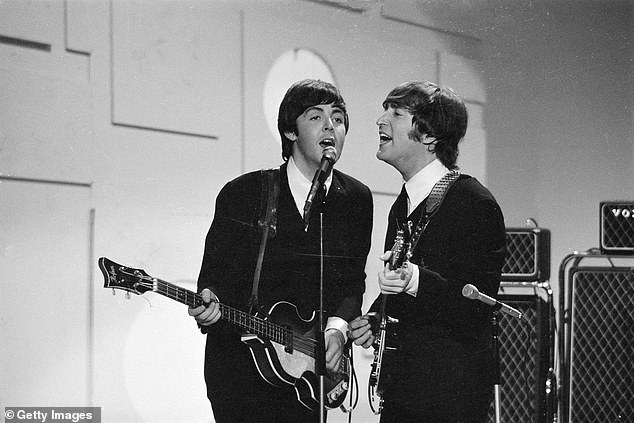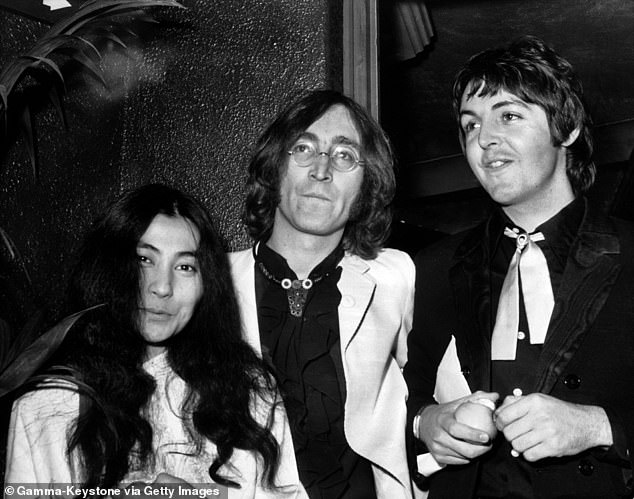John & Paul: A Love Story In Songs by Ian Leslie (Faber & Faber £25, 432pp)
As soon as I finished reading this book, I went to my record collection and pulled out the Beatles’ first three albums.
Some of the songs there hadn’t been played in decades, so I needed to remind myself of just what it was that had captivated the world so many years ago.
And, as I listened to the sheer youthful joy of the Beatles, I remembered that John, Paul, George and Ringo didn’t just perform their songs. They attacked their audience musically in a way no others ever did.
Think only of their first number-one single in unofficial charts, 1963’s Please Please Me. Paul McCartney’s higher register was used almost in the way that writers use italics, excitement being built into the song from the first line.
‘Last night I said these words to my girl, you know you never even try, girl,’ they sing. And then comes the call and response in ascending chords that Lennon and McCartney liked so much: ‘Come on, come on, come on, come on . . . please, please me, oh yeah, like I please you.’
Quite what the supplicants were requiring of the young lady was never explained. It didn’t matter.
After George Harrison’s guitar introduction, the two voices of Lennon and McCartney hit the listeners like a punch in the face. And for the next seven years they just kept doing it.

Best friends: John Lennon and Paul McCartney became firm friends after meeting when they were 16 and 15 respectively
Sometimes the Lennon and McCartney voices would be interwoven into their songs, while in others John might sing the verse while Paul would come in for a solo in the middle eight bars. And then maybe vice versa. The Beatles had two lead singers who wrote their own songs and played them, too.
A Hard Day’s Night is a perfect example of the Lennon and McCartney built-in, best-friend rivalry.
Ringo had accidentally come up with the name of their film and Lennon rushed home to write its theme song before McCartney could use the title to write a different song – although they always shared songwriting credits anyway.
And they were best friends from the time they met at a church fete when John was 16 and Paul 15.
The story of their meeting has been told many times and author Ian Leslie retells it as briskly as he can, but, for me, his real contribution to their story is his understanding of the music of Lennon and McCartney.

Even if only one of them wrote the song, both John and Paul shared songwriting credits for much of their Beatles careers
At first their songwriting was straightforward and they agreed to share a Lennon & McCartney credit, whether or not they had both been involved in the song’s creation. Only the closest of friends would have done that.
This arrangement worked well for the first 150 songs or so. But the writing sessions got trickier when John became involved with Yoko Ono. Paul was now no longer John’s best friend, and John’s jealousy of Paul’s superior musicianship became ever more magnified.
Leslie believes that the different attitudes of the two to the drug LSD, and the end of touring in 1966, had already begun to drive them apart.
But for me the day Yoko Ono, who was never backward in coming forward, appeared at a Beatles’ recording session was the moment the Lennon-McCartney split became irreparable.
At the time I was involved with both Beatles as a journalist and remember the day Paul phoned me and asked me to interview him so that he could put forward his side of the story. He was smarting because he’d been publicly blamed for the Beatles’ break-up, when, in fact, John had been the one responsible.
The problem, Paul told me, was that it had become very difficult for him ‘to write with Yoko sitting alongside John’.
A few days later John gave me his version of the break-up. ‘Why should I work with Paul McCartney when I can work with Yoko Ono?’ he asked rhetorically. There was no polite answer I could have given. In my opinion Yoko gave John Lennon what he imagined to be some kind of artistic credibility.

It was only after John met Yoko did the writing relationship between him and Paul breakdown
What he didn’t realise at the time (although I suspect he must have secretly reflected on it later) was that in a creative sense he and Paul had brought out the best in each other.
John Lennon was right when he broke the Beatles up at the end of the Sixties. Had they stayed together their magic would eventually have dissipated. Killing them at their peak meant that we still remember them so fondly.
It was also time to give Beatle George his freedom to make his solo albums.
Where John and Paul got it badly wrong was to fall out so viciously. It took years for the wounds to heal.
At one point, when John was living with his mistress, May Pang, he considered visiting Paul at a recording session and wondered aloud about writing with him again. But then he went back to Yoko and that possibility disappeared.
The world was devastated when John was murdered in New York in 1980.
But for Paul it meant that the two boyhood friends who together had changed popular music had never been able to fully reconcile their differences; or indeed write together again.






